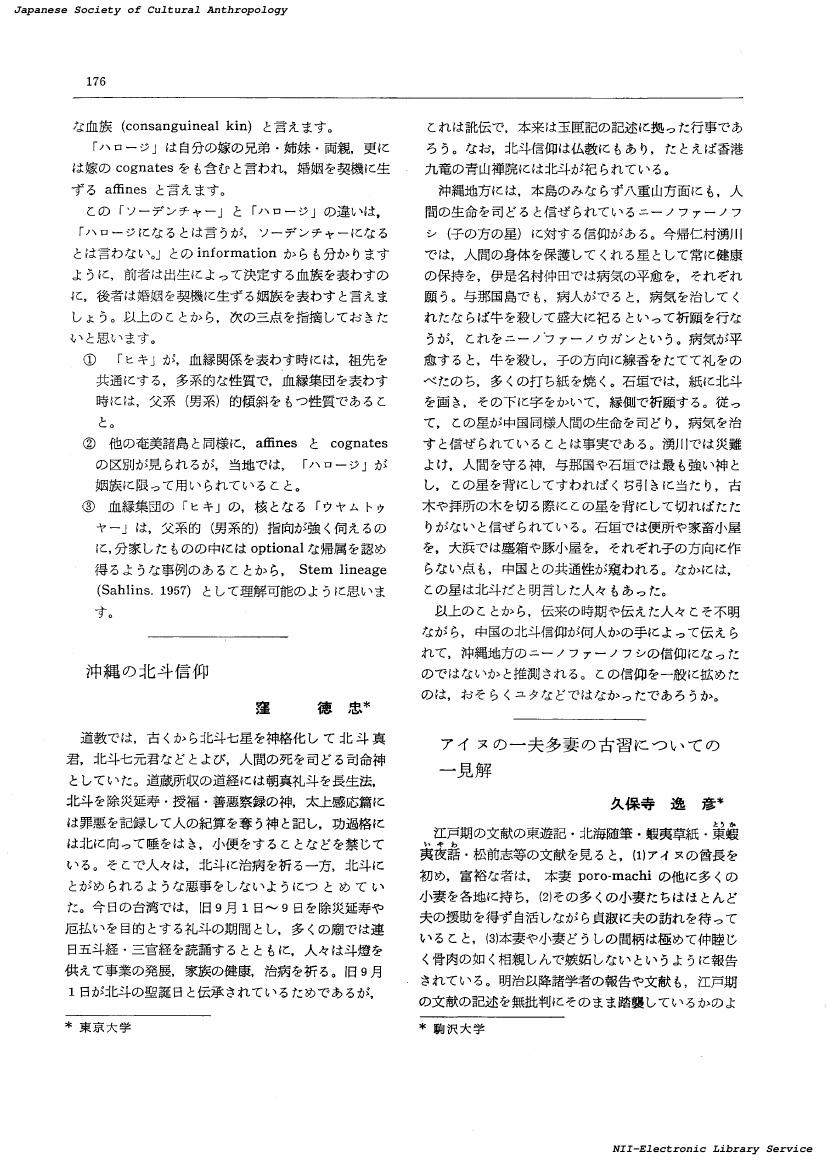7 0 0 0 OA 沙流アイヌの祖靈祭祀(<特集>沙流アイヌの共同調査報告)(金田一京介博士古稀記念)(1)
- 著者
- 久保寺 逸彦
- 出版者
- 日本文化人類学会
- 雑誌
- 民族學研究 (ISSN:24240508)
- 巻号頁・発行日
- vol.16, no.3-4, pp.230-236, 1952 (Released:2018-03-27)
According to the standard literature, the Ainu are indifferent to ancestor worship, as evidenced by the fact that they do not visit the graves of the dead. This judgement is mistaken. It will be shown here that they practice the worship of the souls of their ancestors with no less proper ceremony and frequency than other peoples. The ceremony in question is divided into two categories : nurappa and shi-nurappa. (1) When the Ainu brew a small quantity of sake, or they are presented with it, they hold a small-scale nurappa. (2) Periodically in spring and autumn, and most ceremoniously in winter, each family of the village brews a large quantity of sake and invites many relatives and neighbors and holds a large-scale shi-nurappa. These ceremonies may be performed by themselves or as part of other religious services such as the iomante (bear-festival). Since the dead are considered deities who live in the subterranean divine land in the same way as they did on earth, the souls of the ancestors should be worshipped along with other deities, and other deities are usually worshipped along with the souls of the ancestors. The ceremony for the souls of the ancestors is performed before a special altar, which is erected between the sacred window on the east side of the house and the nusa-san altar in front of the window (Fig.3 on p.53). One male and several females participate in the ceremony. The former is the family-chief, or a representative of his who is aged, eloquent, and well versed in ritual formulae, and should belong to the patrilineal descent of the male ancestors of the family ; the female participants have, as a rule, the same upshor forms (s. p.69) as those of the female ancestors being worshipped on that occasion, that is to say, they belong to their matrilineal descent. The male worshipper erects ceremonial shaved sticks (inau), makes libations, offers prayers to the ancestral souls, and crushes sake-lees, tobacco, cakes, and other offerings in his hand and scatters them around. The female participants also take these offerings in their hand, and crush and scatter them ; in former days, however, they seem to have offered prayers, too. After this the women have a drink by themselves, eat some of the offerings, and dance solace to the ancestral souls ; in the house the men have a feast toward nightfall. Another prevalent misconception is that Ainu women are not qualified to participate in religious ceremonies. Therefore, it is all the more significant that in fact the matrilineal female descendants worship the souls of their female ancestors during these ceremonies. One of the chief findings of our 1951 joint research on the Ainu is the fact that in their social structure matrilineal descent prevailed for females and patrilineal descent for males. The author intends to take this peculiar feature of their social structure into consideration in analyzing their religious rites and ceremonies.
3 0 0 0 OA アイヌの萢瘡神「パコロ・カムイ」に就いて
- 著者
- 久保寺 逸彦 知里 眞志保
- 出版者
- 日本人類学会
- 雑誌
- 人類學雜誌 (ISSN:00035505)
- 巻号頁・発行日
- vol.55, no.3, pp.124-128, 1940 (Released:2010-06-28)
2 0 0 0 アイヌの疱瘡神「パコロ・カムイ」に就いて(下)
- 著者
- 久保寺 逸彦 知里 眞志保
- 出版者
- The Anthropological Society of Nippon
- 雑誌
- 人類學雜誌 (ISSN:00035505)
- 巻号頁・発行日
- vol.55, no.4, pp.169-199, 1940
- 著者
- 久保寺 逸彦
- 出版者
- 日本文化人類学会
- 雑誌
- 民族學研究 (ISSN:24240508)
- 巻号頁・発行日
- vol.36, no.2, pp.176-177, 1971-09-30 (Released:2018-03-27)
1 0 0 0 OA 北海道アイヌの葬制 : 沙流アイヌを中心として
- 著者
- 久保寺 逸彦
- 出版者
- 日本文化人類学会
- 雑誌
- 民族學研究 (ISSN:24240508)
- 巻号頁・発行日
- vol.20, no.3-4, pp.156-203, 1956-12-25 (Released:2018-03-27)
1 0 0 0 OA アイヌの古俗 : 酒の釀造及びその祭儀
- 著者
- 久保寺 逸彦
- 出版者
- 日本文化人類学会
- 雑誌
- 民族學研究 (ISSN:24240508)
- 巻号頁・発行日
- vol.1, no.3, pp.501-532, 1935-07-01 (Released:2018-03-27)
1 0 0 0 IR アイヌの他界観に就いて
- 著者
- 久保寺 逸彦
- 出版者
- 駒澤大学
- 雑誌
- 駒澤大學文學部研究紀要 (ISSN:04523636)
- 巻号頁・発行日
- no.28, pp.39-53, 1970-03
1 0 0 0 アイヌの萢瘡神「パコロ・カムイ」に就いて
- 著者
- 久保寺 逸彦 知里 眞志保
- 出版者
- 日本人類学会
- 雑誌
- 人類學雜誌 (ISSN:00035505)
- 巻号頁・発行日
- vol.55, no.3, pp.124-128, 1940
1 0 0 0 OA 北海道アイヌの葬制 : 沙流アイヌを中心として
- 著者
- 久保寺 逸彦
- 出版者
- 日本文化人類学会
- 雑誌
- 民族學研究 (ISSN:24240508)
- 巻号頁・発行日
- vol.20, no.1-2, pp.1-35, 1956-08-10 (Released:2018-03-27)




